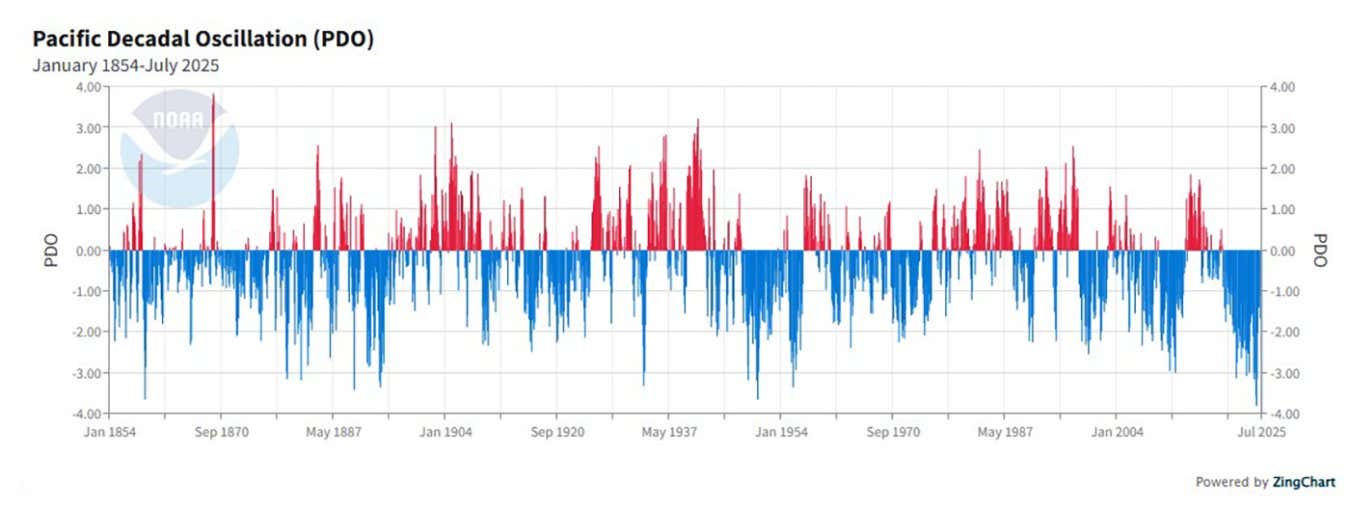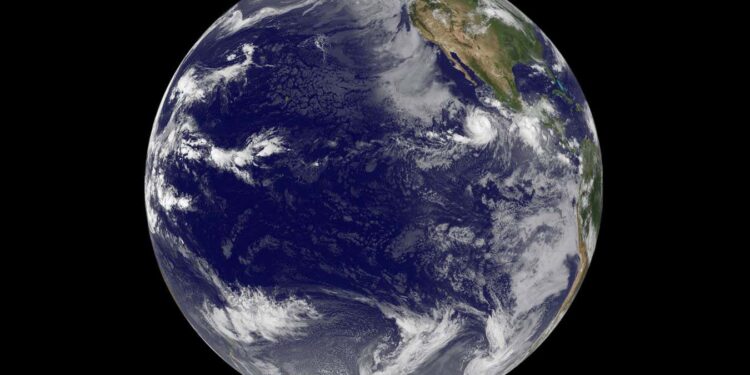
The Pacific Ocean moves through a decades-long cycle of shifting temperatures
NG Images/Alamy
Waters in the northern Pacific Ocean naturally cycle between patterns of cool and warm temperatures every few decades. But hundreds of simulations from climate models suggest human-caused warming may have locked this cycle into a pattern that is driving a megadrought in the western US – and could extend this dynamic for decades.
“We expect that as long as greenhouse gas forcing continues to increase, there will be continued meteorological drought in the western United States,” says Jeremy Klavans at the University of Colorado, Boulder.
Since the 1850s, sea surface temperatures in the northern Pacific Ocean have regularly cycled between a positive phase, with temperatures above average in key parts of the ocean, and a negative one, characterised by cooler-than-average temperatures there. This slow cycle, which takes place over the course of decades, is called the Pacific Decadal Oscillation (PDO).
However, since the late 1980s, this cycle has undergone an extended negative trend. The ocean’s surface has maintained a horseshoe shape of cooler-than-average water surrounding a warmer interior. Last month, this negative phase saw its cooler-than-average temperature anomaly hit a new record.
In previous research, climate models suggested this long-term trend could occur naturally – but it would be a rare once-in-a-millennium event. Klavans and his colleagues thought that seemed unlikely. “Climate models taken at face value didn’t have the answer for us,” he says. “They told us it was bad luck.”
Global warming due to human emissions could be playing a role, but determining whether it had any influence was challenging, since the signal of that influence was relatively weak in the climate models. “It’s been swamped by a bunch of internal noise,” says Klavans.
To isolate the signal, Klavans and his colleagues looked at changes in Pacific Ocean temperatures across nearly 600 simulations of the planet’s climate generated by a suite of models, an effort requiring a massive amount of computing power. Looking at the average change across all these simulations cancelled out the statistical noise generated by each model, revealing the influence of human emissions on long-term trends in the PDO.
Up to 1950, the researchers found human emissions could explain almost none of the changes in the cycle. However, from 1950 on, changes in human emissions could explain about half of the shift. Between 1950 and the 1980s, they found aerosol pollution – which creates a cooling effect by reflecting sunlight – pushed the PDO toward its positive phase. Between 1980 and 2014, a reduction in aerosol pollution in the northern hemisphere, along with the warming effect of greenhouse gases, pushed the PDO toward its negative phase.

The Pacific Decadal Oscillation is a pattern of ocean temperatures
Mantua/NOAA
The researchers’ simulations end in 2014, but the negative trend has continued over the past decade. It persisted despite two El Niños, which are ocean warming events, that were expected to flip the PDO back to its positive phase, says Pedro DiNezio, also at the University of Colorado, Boulder. In a related study, the researchers modelled how further warming would influence the negative trend.
“We looked into the future, and models make it persist for at least a few more decades,” says DiNezio. “As long as the northern hemisphere continues to warm, the PDO will be stuck in this negative phase.”
That is a problem for the western US, as the PDO’s negative phase keeps winter precipitation below average in much of this region. This shift contributes to the exceptionally long megadrought that has parched the western US since the turn of the century. We knew higher local temperatures induced by human-caused climate change exacerbate this drought; a sustained negative PDO is one more way climate change is making the drought worse.
These results are surprising because “it’s challenging the inherited wisdom that the PDO-like pattern is something that arises from internal variability”, says Tripti Bhattacharya at Syracuse University in New York.
The finding also suggests climate models could have a bias towards underestimating human influence on major temperature cycles in the ocean and atmosphere, says Bhattacharya. “We know that the Earth system models have persistent biases in certain regions, and the north Pacific is one of them.”
However, she points out the findings are still limited by biases inherent in models – and there is still work to be done to understand the specific mechanism by which human emissions influence the PDO.
Determining how much of these long-term trends are down to natural variability within the climate system, and how much might be due to the influence of human emissions, “is one of the most fundamental science questions in Earth system science”, says Gerald Meehl at the US National Center for Atmospheric Research in Colorado. “The likely reality is probably some combination of the two.”
Topics:
Source link : https://www.newscientist.com/article/2492423-pacific-ocean-changes-may-lock-in-us-megadrought-for-decades/?utm_campaign=RSS%7CNSNS&utm_source=NSNS&utm_medium=RSS&utm_content=home
Author :
Publish date : 2025-08-13 17:30:00
Copyright for syndicated content belongs to the linked Source.





